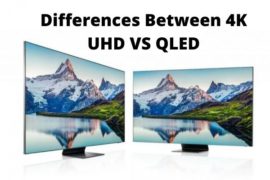Are you planning to get yourself a new TV to watch your favorite movies or playing games in the best picture quality possible?
But you may get entangled in a bit of tech-jargon there. HDR, UHD, SD, 4K – which one to pick?
You finally stopped scratching your head and decided you want 4K! (since they can’t stop talking about it since 2014! Ugh!)
Alright, now it’s time to go to the store and get that thing! But what you didn’t know is the store salesman had a surprise waiting for you.
“4K UHD or 4K HDR?” he asks.
Nope! Don’t scratch your head just yet! 4K UHD vs 4K HDR is a pretty common question nowadays.
Seems too confusing? Ask yourself what they are, which one you need, and what sets these two apart. No worries, I will clear out all of your questions in a bit.
What is 4k UHD?
Commercially available since 2014, 4K resolution is a standard feature for picture quality. 4K suggests that the horizontal display resolution of your screen is 4000 pixels. In reality, your 4K TV has 3840 horizontal pixels and 2160 vertical pixels. The resolution is written as (3840 x 2160).
UHD or Ultra-High-Definition is a term used synonymously to 4K. UHD televisions have a display with an aspect ratio of 16:9. These are currently available in 4K UHD and 8K UHD.
Ultra-High-Definition televisions usually have higher resolution and higher frame rates than a standard 1080p TV (which is why it is also called 4K-UHD).
Basically, 4K Televisions are commercially marketed as UHD, although some differences persist.
What is HDR?
In photographic imaging and films, High-Dynamic-Range Imaging (HDRI) is a technique of producing (or reproducing) a greater range of luminosity than that done with Standard Digital Imaging.
Essentially, HDR produces brighter and more vivid pictures. Often due to Wide Color Gamut technology, HDR TVs demonstrate an almost perfect amount of brightness required for the bright areas and darkness for the dark areas in a picture.
In simple terms, HDR technology is perfect to view anything in the correct light and color contrast.
4K UHD vs 4K HDR
As stated before, commercially 4K televisions are marketed as 4K-UHD TVs. On the other hand, HDR televisions can range in different resolutions (720p, 1080p, 4K, etc.).
A television with 4K resolution (3840 x 2160) is called a 4K UHD TV and the HDR TV with 4K resolution (3840 x 2160) is called 4K HDR TV.
The following table encapsulates 4K UHD vs 4K HDR:
|
4K UHD |
4K HDR |
| Mainly defined as a screen with 3840 horizontal resolutions and 2160 vertical resolution (4K resolution). | A screen with 3840 horizontal resolutions and 2160 vertical resolution, demonstrating the right amount of luminosity and color contrast. |
| UHD Televisions are usually 4K | HDR technology is present in devices with different resolutions other than 4K. |
| 4K UHD is all about the quantity of resolution of the image. | 4K HDR can capture the depth and definition of the image and improve the image’s quality. |
| Color Gamut technology is not used generally. | Wide Color gamut technology available. |
| The improvement of color in 4K is through the increase of definition. | The visuals, including color and contrast, are radically developed. Definition of colors, light, and shadow is demonstrated to its full extent.
The precision of color reproduction and high contrast ratio makes HDR stand out. |
| Although the more definition is added to the color, the quality of color itself is not developed. | The distance between white and black increases, intensifying the contrast without overexposing or underexposing bright and dark colors. |
| In terms of device compatibility, a full 4K-compatible device is necessary in the case of both the source and display equipment. | As many formats of HDR are available, the compatibility of the devices should be end to end in the case of both source and display. |
| 4K content is readily available nowadays, including popular OTP platforms (Netflix, Amazon prime). | In contrast to 4K content, available HDR content is pretty limited. |
The Reality
Realistically speaking, image quality and resolutions do not always stand out. You need the right distance to experience things like that.
However, HDR quality image is easily visible to the viewers as it provides more depth to each frame of the image.
4K HDR, in this case, provides the very best there is. However, the availability of content is an issue.
If the content was not made within HDR technology, the viewing experience would not be as distinguishable even if source-player compatibility is established.
Bottom Line
4K UHD vs 4K HDR is not a logical comparison. Because both UHD and HDR are umbrella terms that encompass many information and attributes. Not all attributes are essentially comparable.
However, HDR is definitely the coming-of-age viewing experience for people. The addition of 4K with HDR has brought the technology to its full potential. It is just a matter of how and when we use it!
The wiser the consumers, the better is the popular technology!
Related Posts:




